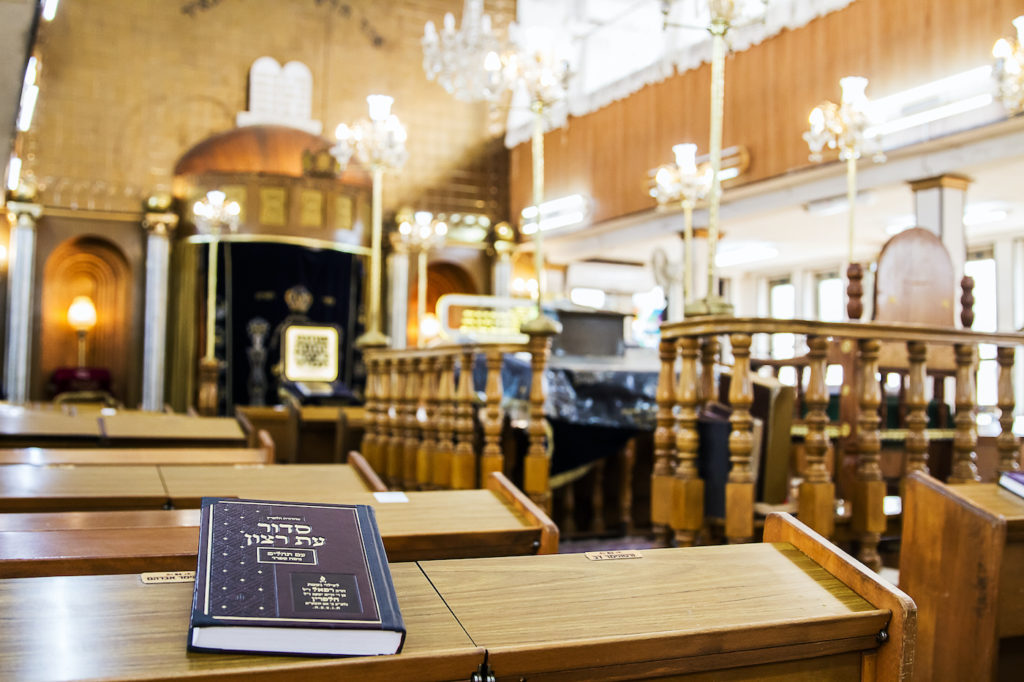When I failed to find Dara Horn’s latest book on the shelves of my local library, I hesitated before requesting assistance.
“Can you help me find People Love Dead Jews?” I finally asked the woman behind the desk.
“People Love . . . ?” The librarian’s voice trailed off into a question, and she looked up at me inquisitively, evidently hoping I would give her a title different from the one she couldn’t possibly believe she had heard.
I repeated myself, and the librarian visibly grimaced. The provocative title of Horn’s work is uncomfortable to say out loud in public, and intentionally so, for nothing quite touches a raw nerve like proclaiming an unspoken truth. In this wide-ranging compilation of essays, Dara Horn, Jewish American novelist and scholar of Hebrew and Yiddish literature, critiques the morbid obsession the world has with dead Jews and the way the narratives about them are usurped for self-serving, ulterior motives. Everyone tends to look for inspiring and universal lessons that can be learned from the countless corpses of Jews. But doing so overlooks a broader understanding to be gained from living Jews, and the vibrant traditions that have sustained Judaism over the millennia.
Start your day with Public Discourse
Sign up and get our daily essays sent straight to your inbox.Dara Horn wrote People Love Dead Jews in response to rising antisemitism in the United States. The 2018 shooting at the Tree of Life Synagogue in Pittsburgh—thought to be a singular stain on American soil—was followed by a 2019 synagogue shooting in San Diego, an attack on a kosher supermarket in Jersey City, and a stabbing spree at a Chanukah party in my hometown of Monsey, New York. A year and a half after its publication, this book has yet to lose its relevance as religious Jews continue to be beaten in broad daylight on the streets of Brooklyn and celebrities spout antisemitic rhetoric that their sycophantic fans promulgate even further.
The essays in People Love Dead Jews span time and space, mirroring the reality of Jews scattered across diasporic exile, with the threat of antisemitism rearing its protean, monstrous head any time and anywhere. The list of chapters reads like an unceasing obituary: “Dead American Jews” (Parts One, Two, and Three), “Executed Jews,” “Fictional Dead Jews,” “Legends of Dead Jews,” “Blockbuster Dead Jews.” The necrology goes on. Having called upon so many souls, Dara Horn carefully uncovers the sinister motives underlying so many seemingly benign (or even well-intentioned) treatments of the Jews. Horn travels to the far-flung frozen city of Harbin, China, to visit the Jewish Museum commissioned by the Chinese government commemorating the Russian Jews who built the city. However, as Horn notices, the memorialization neglects to mention the nefarious history of Russian, Japanese, and Chinese extortionists and murderers who drove the Jews away. Horn also exposes canonized antisemitism in the Western literary tradition. She finds Elizabethan England and contemporary society’s acceptance of Shakespeare’s The Merchant of Venice troubling: the dehumanization of the Jews through the caricature of Shylock has seeped so fully into popular culture that not only is the use of casually antisemitic tropes commonplace, but protesting its normalization is viewed as bizarre.
The Trouble with the Holocaust
People are interested in dead Jews because the deceased are easily contained, managed, and used for moralizing. The museumification of the Holocaust provides a clear example. It is said that the master plan of the Nazis was to destroy the Jews and erect a Museum of the Extinct Race propagating the preferred narrative of the Third Reich, and in some ways, they succeeded. Today, museums filled with the stolen goods of Jews abound, and their placards relay carefully curated definitions with which dead Jews cannot argue.
The Holocaust continues to be one big lesson. Horn writes that, in the hands of the world, dead Jews are “people whose sole attribute was that they had been murdered, and whose murders served a clear purpose, which was to teach us something. Jews were people who, for moral and educational purposes, were supposed to be dead.” Holocaust victims, with the many vainglorious memorials that have been erected in their memory, fall into this category. While Holocaust curricula employed in schools around the country intend to teach about the dangers of intolerance, for many students their first and only encounter with Jews is with dead ones in black and white photographs.
People are interested in dead Jews because the deceased are easily contained, managed, and used for moralizing. The museumification of the Holocaust provides a clear example.
Horn knows that interest in dead Jews does not always translate into respect for living Jews. To prove her point, her opening essay reports how the Anne Frank House in Amsterdam banned a Jewish employee from wearing his yarmulke to work. The museum, with one million annual visitors, claimed that “a Jew with a yarmulke might ‘interfere’ with the museum’s ‘independent position’” and, as Horn wryly remarks, took four months to deliberate whether to force another Jew into hiding.
The public loves Anne Frank because her words are “inspiring,” which means—with Horn’s cutting gloss—“they flatter us.” Anne is secular, young, relatable, and writes niceties about cute boys and celebrating Christmas from the small corner of her annex. Her most famous soundbite—“I still believe, in spite of everything, that people are truly good at heart”—is a sentiment that assuages the world’s guilty conscience. That is, until Dara Horn reminds the reader that those words were written three weeks before she met “people who weren’t.”
Even if the world knew all about Anne Frank’s deportation from Westerbork, to Auschwitz, to Bergen-Belsen where she died of typhus, a Holocaust-centric understanding of the Jewish people still fails to realize the rich complexity that is Jewish life. It is hardly sufficient to be well-versed in the sordid details of gassings and murder-by-bullets, or even the musings of a teenage girl in hiding, without learning about what makes Jewish life valuable and unique. As Dara Horn laments, people can name more concentration camps than they can Yiddish writers.
“What Is the Secret of His Immortality?”
Instead of focusing on what the world has done to the Jews, it is far more worthwhile to investigate the way Jews have not only survived, but thrived. Mark Twain ponders the question of Jewish endurance in his 1898 essay “Concerning the Jews” after noting that the Jew’s “contributions to the world’s list of great names in literature, science, art, music, finance, medicine, and abstruse learning are also away out of proportion to the weakness of his numbers.” The Jew accomplished this “with his hands tied behind him,” and Twain asks: “All things are mortal but the Jew; all other forces pass, but he remains. What is the secret of his immortality?”
Varian Fry, discussed in Dara Horn’s essay on rescuing Jews, might be one partial answer to Mark Twain’s question. Intent on saving the premier minds of a burning Europe, Fry volunteered to distribute 2,000 visas to a handpicked selection of Europe’s greatest artists and intellectuals. It is almost impossible to earn an undergraduate degree without encountering at least one name on Fry’s to-rescue docket: Hannah Arendt, Marc Chagall, Claude Lévi-Strauss, Walter Benjamin (this last attempt failed). Those Fry saved went on to radically reshape American institutions, from the universities to Hollywood.
But the goodwill of an art patron alone is not the secret to the Jew’s immortality. In fact, placing a premium on prestige overlooks what is most foundational to Jewish life. There is a cost to valuing the humanities over humanity. Horn says it well:
It is easy to forget that there are other values a culture might maintain, other people whom one could consider guardians of civilization instead of artists and intellectuals—and that a large proportion of the people who were actually murdered in the Holocaust adhered to one of these alternatives. . . . [N]o one tried to save the culture of Hasidism, for example, with its devotion to ordinary, everyday holiness—or Misnagdism, the opposing religious movement within the traditional Eastern European Judaism, whose energy in the years before the war was channeled into the rigorous study of musar, or ethics. . . . No rescue committee was convened on behalf of the many people who devoted their lives and careers to . . . the actual study of righteousness.
The world fails to recognize that it’s the actual study—and practice—of righteousness that contributes to the Jews’ immortality. As Ahad Ha’am, the Zionist philosopher, remarked: “More than the Jews have kept the Sabbath, the Sabbath has kept the Jews.” Although advancements in science and the arts made by Jews are notable, it’s the adherence to tradition that sustains and promises the continuity of the Jewish people.
The fortuitous salvation of the entire faculty and student body of the Mirrer Yeshiva, a premier institution of advanced Talmud study, presents a curious case in the survival of a school of Jewish thought. As Dara Horn mentions on her podcast, similarly titled People Love Dead Jews, the Japanese government’s interest in Jews, while based on the fundamentally antisemitic belief that Jews control the world and its finances, actually permitted Jews fleeing Europe to find refuge in Japan. Chiune Sugihara, a Japanese diplomat stationed in Kovno, Lithuania during World War II, issued more than 2,000 visas to otherwise helpless Jews (and was ultimately fired by the government for surpassing the established quotas). Those Sugihara saved included the Mirrer Yeshiva, which relocated from Nazi-occupied Lithuania to safety in Japanese-controlled Shanghai. Unlike Fry, Sugihara did not use an elitist measuring stick to determine who “deserved” to live. Today, the Mir—which has since moved to Jerusalem—is the largest yeshiva in the world, with more than 9,000 students, and there are more than 100,000 descendants of the families Sugihara rescued.
Although advancements in science and the arts made by Jews are notable, it’s the adherence to tradition that sustains and promises the continuity of the Jewish people.
Dara Horn was initially deeply unsettled by the lack of gratitude Fry’s celebrity list had toward their rescuer. However, the admirable traits of righteousness that Dara Horn was searching for can be found in the noteworthy appreciation displayed by the Jews saved by Sugihara. The Mirrer Yeshiva, acting on the Jewish principle of hakaras hatov or gratitude (regardless of Japan’s underlying antisemitic motives that brought Jews into their country), showed their thankfulness by inviting Japanese guests for the 50th anniversary marking the yeshiva’s relocation from Lithuania to Japan. Sugihara was posthumously honored at the dinner, and Mirrer grade school children visited the current consul to thank him in Japanese. The appreciation extended beyond Sugihara to include his family; Nobuki Sugihara, Chiune’s youngest son, was given a scholarship in 1968 to attend Hebrew University in Israel and was trained in the diamond business by leading Jewish jewelers. This level of appreciation comes from Jews devoted to the Jewish tradition, a tradition that demands turning thoughts into action.
To answer Mark Twain’s question: the secret to the Jew’s immortality is his commitment to tradition. Twain notes the contributions Jews have made to various fields—the fields that Varian Fry was similarly preoccupied with—while overlooking the most important one: “the study of righteousness” that establishes a practicable ethical system capable of sustaining a long-lasting civilization.
Look at Living Jews
Even in the twenty-first century, despite cultural and technological upheaval, Jewish vibrancy hasn’t dimmed. The Jewish people persist with an internal strength. In 2015, I joined 13,000 other high school girls in Barclays Center (The Nets’ arena in Brooklyn) to commemorate the 80th memorial anniversary of Sarah Schenirer, a Polish seamstress who revolutionized the educational scene for young Jewish women by founding the Bais Yaakov movement in 1917. The establishment of Bais Yaakov legitimized Torah learning for Orthodox Jewish women and created an institution where young women could develop themselves spiritually and intellectually. The teachers Schenirer trained before she died in 1935 kept the faith of their fellow young women, even in the concentration camps. Today, a multitude of schools around the globe boast Bais Yaakov’s name with more than enough students to fill a stadium.
Another visit to Barclays Center coincided with an event Dara Horn discusses in her final chapter: the 2020 Siyum HaShas. The Siyum HaShas celebrates the completion of the Daf Yomi cycle, the daily study of one of 2,711 pages of Talmud, which takes 7 years and 5 months to complete. The initiative of Daf Yomi—one page a day—was proposed by Rabbi Meir Shapiro at the First International Congress of the Agudath Israel World Movement in Vienna in 1923. A century later, thousands of Jews around the world are still quite literally on the same page, breathing life into the two-thousand-year-old Talmud by practicing the values and ideas discussed in the text. I attended Barclay’s Center with 19,000 men and women, while 90,000 other Jews packed Met Life Stadium, and thousands more around the world rejoiced in this epic accomplishment of the Jewish people.
Thousands of Jews around the world are still quite literally on the same page, breathing life into the two-thousand-year-old Talmud by practicing the values and ideas discussed in the text.
In her essays on “Dead American Jews,” Dara Horn writes about how she was first devastated, then angry, and finally, defeated at the unrelenting antisemitic attacks on American Jewry. But the Living American Jews—the ones filling stadiums in January 2020 to celebrate tradition, commitment, and endurance—gave her hope. Dara Horn writes that she has taken up Daf Yomi, daily Talmud study, to join in the Jewish tradition’s open-ended, everlasting conversation.
The attack in Monsey, New York at the home of Rabbi Rotenberg made national news and is featured in People Love Dead Jews. But not many people know that the following day, the inauguration of a new Torah scroll at a nearby synagogue filled the streets with music and people, dancing and singing. I was fortunate to witness the procession, which stopped in front of the home of Rabbi Rotenberg, who came out to greet them. Together, they sang and danced, irrevocably intertwined with the Torah scroll and the tradition it represents, showing that Jewish life goes on: joyous and unafraid, strengthened with an undying perseverance that makes the Jewish people immortal.














